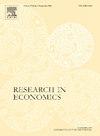Re-assessment of sustainability of current account deficit in India: Insights from threshold cointegration and NARDL analysis
IF 1.2
Q3 ECONOMICS
引用次数: 0
Abstract
I examine the sustainability of CAD by employing both linear and threshold cointegration (Enders and Siklos, 2001) and Engle-Granger (1987) from the period 1960 to 2019. Results of the threshold and Engle-Granger cointegration confirm long-run equilibrium association between exports and imports indicating strong presence of sustainability of CAD in India. This reveals that after certain threshold level of current account deficit i.e., 3%, both export and import have different speed of adjustment towards long-run and their adjustment is asymmetric in nature. These results reveal that after certain threshold level of current account deficit, there should be systematic policy to adjust short-run behaviour of imports to bring back to the long-run for sustainability of current account deficit in India. The policy makers should consider the nonlinear behaviour of current account deficit while formulating any policy prescription towards sustainability of current account deficit in India. The export sector has to be encouraged and the import sector has to be restricted by implementing tight import restricted policies. Further, based on the threshold cointegration and asymmetric error correction mechanism, after estimated threshold, both exports and imports react differently to short-run positive and negative shocks. However, sufficient condition of intertemporal budget constraint is not satisfied by NARDL method. Overall findings conclude that CAD in India is weakly sustainable. Following the empirical results some policy suggestions are suggested.
印度经常账户赤字可持续性的再评估:来自阈值协整和NARDL分析的见解
从1960年到2019年,我通过采用线性和阈值协整(Enders and Siklos, 2001)和Engle-Granger(1987)来检验CAD的可持续性。阈值和恩格尔-格兰杰协整的结果证实了出口和进口之间的长期均衡关联,表明印度CAD的可持续性很强。这表明,在一定的经常账户赤字阈值水平(即3%)之后,出口和进口都有不同的长期调整速度,其调整本质上是不对称的。这些结果表明,在一定的经常账户赤字阈值水平之后,应该有系统的政策来调整进口的短期行为,以使印度的经常账户赤字回到长期的可持续性。政策制定者在制定印度经常账户赤字可持续性政策处方时,应考虑经常账户赤字的非线性行为。必须鼓励出口部门,并通过执行严格的进口限制政策来限制进口部门。此外,基于阈值协整和非对称误差修正机制,在估计阈值后,出口和进口对短期正冲击和负冲击的反应不同。然而,该方法不满足跨期预算约束的充分条件。总体结果表明,印度CAD的可持续性较弱。根据实证结果,提出了政策建议。
本文章由计算机程序翻译,如有差异,请以英文原文为准。
求助全文
约1分钟内获得全文
求助全文
来源期刊

Research in Economics
ECONOMICS-
CiteScore
1.40
自引率
0.00%
发文量
37
审稿时长
89 days
期刊介绍:
Established in 1947, Research in Economics is one of the oldest general-interest economics journals in the world and the main one among those based in Italy. The purpose of the journal is to select original theoretical and empirical articles that will have high impact on the debate in the social sciences; since 1947, it has published important research contributions on a wide range of topics. A summary of our editorial policy is this: the editors make a preliminary assessment of whether the results of a paper, if correct, are worth publishing. If so one of the associate editors reviews the paper: from the reviewer we expect to learn if the paper is understandable and coherent and - within reasonable bounds - the results are correct. We believe that long lags in publication and multiple demands for revision simply slow scientific progress. Our goal is to provide you a definitive answer within one month of submission. We give the editors one week to judge the overall contribution and if acceptable send your paper to an associate editor. We expect the associate editor to provide a more detailed evaluation within three weeks so that the editors can make a final decision before the month expires. In the (rare) case of a revision we allow four months and in the case of conditional acceptance we allow two months to submit the final version. In both cases we expect a cover letter explaining how you met the requirements. For conditional acceptance the editors will verify that the requirements were met. In the case of revision the original associate editor will do so. If the revision cannot be at least conditionally accepted it is rejected: there is no second revision.
 求助内容:
求助内容: 应助结果提醒方式:
应助结果提醒方式:


